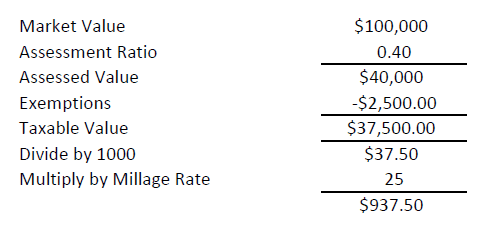How Do Elkhart City Tax Assessors Determine Property Tax?
Gotta love taxes. You have to not only pay taxes on your income but you also have to pay taxes on property you own. How exactly are those Elkhart property taxes calculated by your city officials?
Property tax is a critical source of revenue for local governments. Take Elkhart County for example.
Elkhart County government leaders create a spending budget that includes many parts to it but one you commonly may know of is the education system. Part of the budget goes towards the Elkhart Community Schools system in order to improve the Elkhart schools and the quality of education your child or relative’s child may receive.
In order to fund this spending budget, the government imposes taxes on its citizens since much of the spending is for your benefit and enhancement of quality of living in that city.
Thus, we introduce the property tax to property owners.
The Property Tax Process
The property tax is an ad valorem tax meaning it is levied as a percentage of value. So rather than tax the income earned on the property, the tax is based on the value of the property.
Property tax is often expressed in millage rates rather than percentage rates. They’ve got to do something to confuse the average citizen don’t they?
What is a millage rate? One mill is equal to one dollar of tax for every one thousand dollars of value. Therefore, one mill equals 0.001 or 1/1000 of $1.
Property values are determined by what the market would pay if the property were brought for sale to the market. Tax assessors often take only a portion of this property value to assess tax on, which is known as assessed value.
The fraction used to determine assessed value from market value is known as the assessment ratio. For example, let’s say you live in Michigan and they have an assessment ratio of 40% or 0.40. If your property value is $100,000, then your assessed value would be 40% of that or $40,000. Then the tax levied on your property would be the assessed value multiplied by the millage rate of your city.
But in reality it’s not that simple. Let me explain.
There are exemptions that you may qualify for that will further reduce you assessed value further before multiplying it by the millage rate, for example, the homestead exemption for being an occupying resident of the property or a veteran exemption that discounts property taxes veterans have to pay.
Let’s take the equation from the top.
- Market value of your property
- Multiplied by the assessment ratio
- Equals Assessed Value
- Minus any exemptions
- Equals Taxable Value
- Divided by 1,000
- Multiplied by Millage Rate (25 for example)
- Equals Property Tax
You could skip a step by dividing 25 by 1000 ahead of time to get that decimal rate to multiply the taxable value by if you wanted to.
Here is a math example:

Government Administering the Property Tax
In the eyes of the government there are 3 steps to administering the property tax:
- Property Value Assessment
- Development of the Budget and Tax Rate
- Tax Billing and Collection
Focus 1: Property Value Assessment:
The government will have property assessors also known as property appraisers go out in the city and assess the entire market value of the whole market within the city jurisdiction. To help, many appraisers will use mass appraisal methods or statistical models since there are so many properties within the city district needing assessed. Tax payers may appeal the tax assessment if they disagree.
Focus 2: Development of the Budget and Tax Rate
After developing a budget, the government will subtract all revenues coming from other taxes and nontax sources to get a remaining deficit that must be funded by property tax revenue. This remainder is divided by the taxable values of all properties in the jurisdiction to determine the tax rate.
For example, if you city needs to raise $20 million in property taxes and the total taxable value of all the properties in the city is $1 billion, then dividing $20 million by $1 billion results in a 0.02 tax rate.
Remember the tax rate is expressed as the rate per thousand dollars of assessed value where 1/1000 is one mill. So 2% of 1000 would be 20 mills or $20 for every $1,000 assessed value.
Focus 3: Tax Billing and Collection
Usually you pay property taxes twice per year which means every 6 months. Some states may only bill annually or may bill quarterly. If you do not pay your property taxes, the government who is owed the taxes can place a lien on the property for the unpaid taxes. Plus they can place a penalty and interest on the property as well. Once a certain period of time passes and the taxes still haven’t been paid, the next step of action is seizing the property and selling it at auction to satisfy the tax lien. A tax sale in other words is like a foreclosure basically.
Want a Free Home Value Estimate?
Enter your name and property address below and Team Foy (Kevin + Nick) will respond back within 24-48 hours about the next steps to estimate the value of your property. This is a free quote, no obligation to work with Team Foy to sell your house, but your business would be much appreciated! We strive to service clients with a fast home sale and at the best price we can get you in the market.
Thanks for reading,
Kevin Foy & Nick Foy
Team Foy with RE/MAX Oak Crest Realty
Text or Call – 574-387-2501
Email – Nick@TeamFoy.com
If you are a news website, realtor blog, or other online media, please credit this article by linking to it if used for the data and research in your own publication!

